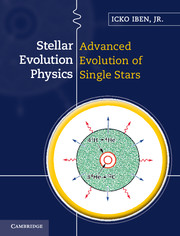Book contents
- Frontmatter
- Contents
- Preface
- Part IV Transport processes, weak interaction processes, and helium-burning reactions
- 12 Particle diffusion and gravitational settling
- 13 Heat conduction by electrons
- 14 Beta decay and electron capture in stars at high densities
- 15 Current–current weak interactions and the production of neutrino–antineutrino pairs
- 16 Helium-burning nuclear reactions and energy-generation rates
- Part V Evolution during helium-burning phases
- Part VI Terminal evolution of low and intermediate mass stars
- Index
- References
13 - Heat conduction by electrons
from Part IV - Transport processes, weak interaction processes, and helium-burning reactions
Published online by Cambridge University Press: 05 December 2012
- Frontmatter
- Contents
- Preface
- Part IV Transport processes, weak interaction processes, and helium-burning reactions
- 12 Particle diffusion and gravitational settling
- 13 Heat conduction by electrons
- 14 Beta decay and electron capture in stars at high densities
- 15 Current–current weak interactions and the production of neutrino–antineutrino pairs
- 16 Helium-burning nuclear reactions and energy-generation rates
- Part V Evolution during helium-burning phases
- Part VI Terminal evolution of low and intermediate mass stars
- Index
- References
Summary
Because faster moving particles at higher temperatures transfer energy to more slowly moving particles at lower temperatures, the very existence of a temperature gradient implies a flow of energy in the direction in which the temperature decreases. In the stellar interior, because of their small mass and consequent high velocities, free electrons are the dominant contributors to this mode of thermal energy transfer, which is called thermal or heat conduction.
Thermal conduction does not play a significant role in transporting heat in stars during most of the main sequence phase. However, towards the end of the main sequence phase, as detailed in Chapter 11 of Volume 1 (Section 11.1), low mass stars develop hydrogenexhausted cores in which electrons become increasingly degenerate, and evolve into red giants with fully electron-degenerate helium cores. Under electron-degenerate conditions, only those electrons with energies within about kT of the Fermi energy ϵF participate in transporting heat, but their average cross section for scattering from ions and other electrons is reduced by a factor of the order of (kT/ϵF)2 relative to their average cross section under non-degenerate conditions. Hence, conduction becomes very effective in slowing the rate at which temperatures increase in the electron-degenerate cores and prevents low mass red giants from igniting helium until the degenerate core has grown to almost one-half of a solar mass. As described in Chapters 17 and 18 of this volume, electron conduction plays a similar role in both low and intermediate mass stars after they have exhausted helium at their centers and become asymptotic giant branch stars with electron-degenerate carbon–oxygen or oxygen–neon cores.
- Type
- Chapter
- Information
- Stellar Evolution Physics , pp. 941 - 978Publisher: Cambridge University PressPrint publication year: 2012



